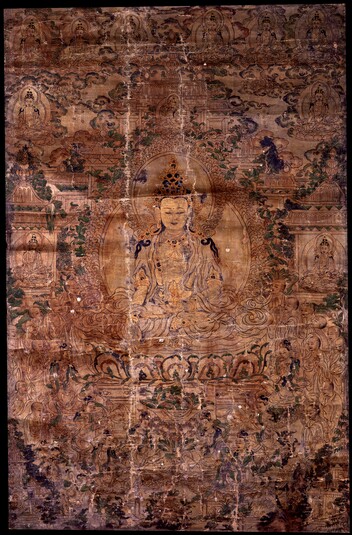
Item: Akshobhya Buddha
| Origin Location | Tibet |
|---|---|
| Date Range | 1600 - 1699 |
| Size | 75.57x49.20cm (29.75x19.37in) |
| Material | Ground Mineral Pigment on Cotton |
| Collection | The Brooklyn Museum of Art |
| Catalogue # | acc. #BMA 78.138, Gift of Miss Alice Boney |
Classification: Deity
Akshobhya, Buddha (Tibetan: mi kyu pa, sang gye) seated in the pureland of Abhirati: a minor Buddha within the sutra tradition of the Mahayana and a principal Buddha within Vajrayana Buddhism residing in the eastern quarter of a mandala. The back of the painting is inscried with the names of the various deities.
"Arising in the eastern direction is Akshobhya on an elephant, lotus and moon throne; with a body blue in colour the right hand is placed in the mudra of pressing down." (Dragpa Gyaltsen, 1147-1216).
Occupying a central role in Vajrayana Buddhism, Akshobhya, by some accounts, is Lord of the 2nd of the Five Buddha Families of tantra and found throughout all 4 tantra classifications most notably in the anuttarayoga class. Akshobhya is also mentioned in several Mahayana sutras, the Vimalakirti Nirdesa being the most famous. It was in his pureland of Abhirati, attainable only by 8th level bodhisattvas, where the great Tibetan yogi Milarepa and the scholar Sakya Pandita obtained complete buddhahood.
Jeff Watt 3-2002
Publication: Tibetan Painted Scrolls
Thematic Sets
Buddhist Deity: Akshobhya Buddha Main Page (阿閦佛)
Collection of Brooklyn Museum of Art
Buddhist Deity: Akshobhya Buddha (Abhirati Pureland)
Collection of Brooklyn Museum of Art (Buddhas)

